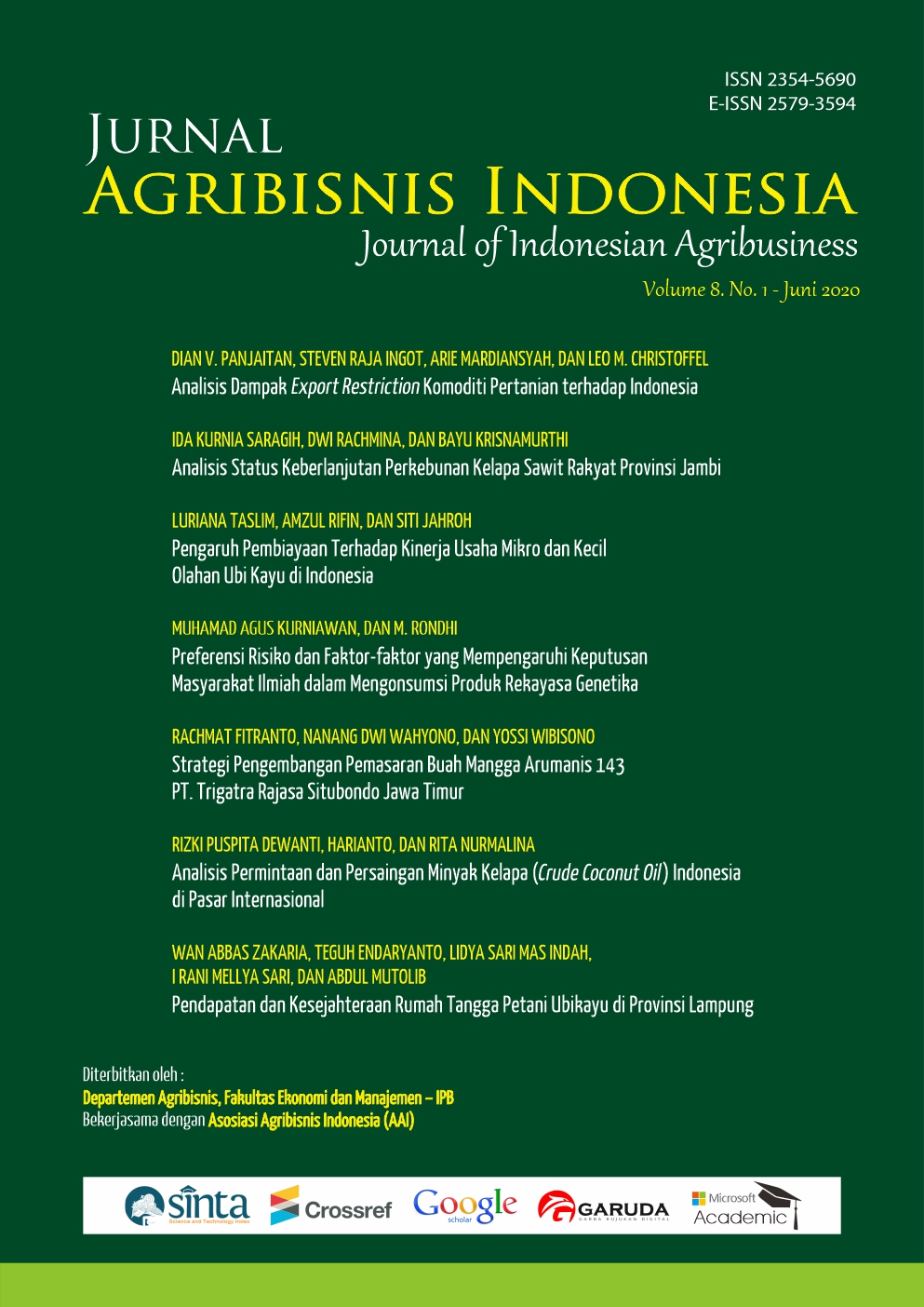Preferensi Risiko dan Faktor-Faktor Yang Mempengaruhi Keputusan Masyarakat Ilmiah Dalam Mengonsumsi Produk Rekayasa Genetika
Main Article Content
Abstract
The purpose of this study was to find out: the perception of Genetically Modified Organisms (GMO) Products and preferences of risk consuming GMO as well as the factors that influence decisions of the scientific community in consuming GMO. This research used descriptive and analytic method. Determination of the area by purposive method at the University of Jember. Method of determining the sample uses purposive sampling, namely students and lecturers from the Public Health Faculty and Agriculture Faculty. Furthermore, determining the number of samples using quota sampling, 150 students and 90 lecturers. The method of collecting survey data using questionnaires and data were analyzed based on questionnaires that returned and were responded to as many as 120 for students and 30 for lecturers. The results of the study show that (1) public perceptions regarding GMO based on health and agriculture are agreed, while the economy is hesitant. (2) risk of preference majority of the scientific community is a risk lover, which is as many as 80 people. (3) Factors that influence the scientific community's decision to consume GMO products significantly, type of work, age, amount of allowance or income per month, daily food expenditure, knowledge level and risk aversion level.
Downloads
Article Details
Jurnal Agribisnis Indonesia (JAI) is an Open Access Journal. The authors who publish the manuscript in this journal agree to the following terms:
Creative Commons License
JAI is licensed under a Creative Commons Attribution 4.0 International License. This permits anyone to copy, redistribute, remix, transmit, and adapt the work provided the original work and source are appropriately cited.
This means:
(1) Under the CC-BY license, authors retain ownership of the copyright for their article, but authors grant others permission to use the content of publications in Jurnal Agribisnis Indonesia in whole or in part provided that the original work is properly cited. Users (redistributors) of JAI are required to cite the original source, including the author's name, JAI as the initial source of publication, year of publication, volume number, issue, and Digital Object Identifier (DOI); (2) Authors grant JAI the right of first publication. Although authors remain the copyright owner.
References
Baker, G. A., dan T. A. Burnham. 2001. Consumer Response to Genetically Modified Foods : Market Segment Analysis dan Implications for Producers and Policy Makers. Journal of Agricultural dan Resource Economics 26(2): 387–403.
Bennet, J. W. 1998. Mycotechnology: The Role of Fungi in Biotechnology. Journal of Biotechnology 66(1):101-107.
Blair, E., dan K. Inniss. 2011. Student evaluation questionnaires and the developing world: An examination of the move from a hard copy to online modality. Studies in Educational Evaluation 40 (2014): 36–42.
Carletto, C., A. Zezza, dan R. Banerjee. 2013. Towards Better Measurement of Household Food Security : Harmonizing Indicators dan the Role of Household Surveys. Global Food Security 2(1): 30–40.
Hidayat, Y. R. 2014. Persepsi Masyarakat terhadap Tanaman Transgenik di Kabupaten Cirebon. Jurnal Agrijati 26(1): 1-14
Holt, C. A., dan S. K. Laury. 1980. Risk Aversion dan Incentive Effects. The American economic Review 92(5): 1644–1655.
ISAAA. 2017. 22 Years of Biotech Crops in the World. Diunduh tanggal 20 Desember 2018 dari www.isaaa.org
ISAAA. 2017. Global Status of Commercialized Biotech/GM Crops in 2017: Biotech Crop Adoption Surges as Economic Benefits Accumulate in 22 Years. Manila. Diunduh tanggal 20 Desember 2018 dari www.isaaa.org
Loureiro, M, L., dan S. Hine. 2002. Economics : Discovering Niche Markets : A Comparison of Consumer Willingness to Pay for Local (Colorado Grown), Organic dan GMO-Free Products Discovering Niche Markets : A Comparison of Consumer Willingness to Pay for Local (Colorado Grown), Organic. Journal of Agricultural and Applied Economics 55(1): 477–87.
Messeguer, J. 2003. Gene Flow Assesment in Transgenic Plants. Plant Cell, Tissue and Organ Culture 73(1): 201-212.
Mulyani, A., D. Kuncoro, D. Nursyamsi, dan F. Agus. 2016. Modern Invention of the Sanscrit Alphabet. Tanah dan Iklim 40(2): 329–30.
Prasifka, P. L., R. L. Hellmich, J. R. Prasifka dan L. C. Lewis. 2007. Effect of CryaAb-Expressing Corn Anthers on the Movement of Monarch Butterfly Larvae. Transgenic Plant and Insect 36(1):1-6.
Prianto, Y. dan S. Yudhasasmita. 2017. Tanaman Genetically Modified Organism (GMO) dan Perspektif Hukumnya di Indonesia. Journal of Biology 10(2): 133-142.
Saragih, E. S., S. R. P. Sitorus, Harianto dan S. Moeljopawiro. 2009. Analisis Kelayakan Ekonomi, Keberlanjutan Usahatani dan Faktor-Faktor Penentu Adopsi Benih Jagung Transgenik di Indonesia. Agro Ekonomi 27(1): 23-44.
Setiawan, A., A. M. Disrinaman, U. Priastuti, dan N A. Novitrie. 2018. Sosialisasi Dampak Pemakaian Bahan Kimia Rumah Tangga Dan Bahan Aditif Makanan Terhadap Kesehatan Keluarga. Cakrawala Maritim 1(1): 15–20.
Shew, A. M., L. L. Nalley, D. M. Danforth, B. L. Dixon, R. M. Nayga, A. C. Delwade dan B. Valent. 2016. Are All GMOs the Same? Consumer Acceptance of Cisgenic Rice in India. Plant Biotechnology Journal 14(1): 4–7.
Siregar, F. ST., S. Andasyari dan T. D. Ansar. 2012. Rekayasa Genetik: Manfaat dan Dampak Negatifnya Terhadap Kehidupan Manusia. Rekayasa Genetika 1(1): 1–12.
Slette, J. dan T. Rahayu. 2013. Agricultural Biotechnology Annual. GAIN Report 1(1): 1-15.
Smith, J. 10 Reasons to Avoid GMOS. 2011. Diakses pada tanggal 9 November 2019
dari http:// responsibletechnology.org/ 10-reasons-to-avoid-gmos. Diakses pada tanggal 9 November 2019.
Subandi, Baban. 2008. Pengetahuan Dan Penerimaan Konsumen Berpendapatan Tinggi Di Bogor Terhadap Keripik Kentang [Skripsi]. Bogor: Program Sarjana Eksistensi Manajemen Agribisnis Institut Pertanian Bogor.

